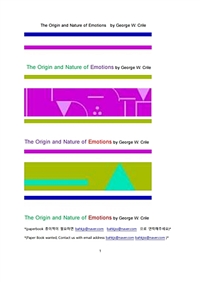
- 평점평점점평가없음
- 저자GW Crile
- 출판사뉴가출판사
- 출판일2020-02-16
- 등록일2020-12-09
- 파일포맷pdf
- 파일크기559 K
- 지원기기
PCPHONETABLET 프로그램 수동설치전자책 프로그램 수동설치 안내
아이폰, 아이패드, 안드로이드, 태블릿, PC
책소개
의학적 희로애락의 감정의 기원과 본성.The Origin and Nature of Emotions by George W. Crile
PREFACE
IN response to numerous requests I have brought together into this volume
eight papers which may serve as a supplement to the volumes previously
published[ *] and as a preface to monographs now in preparation.
[ *] Surgical Shock, 1899; Surgery of the Respiratory System, 1899; Problems
Relating to Surgical Operations, 1901; Blood Pressure in Surgery, 1903;
Hemorrhage and Transfusion, 1909; Anemia and Resuscitation, 1914; and
Anoci- association, 1914 (with Dr. W. E. Lower).
In the first of these addresses, the Ether Day Address, delivered at the
Massachusetts General Hospital in October, 1910, I first enunciated the Kinetic
Theory of Shock, the key to which was found in laboratory researches and in a
study of Darwin's "Expression of the Emotions in Man and in Animals," whereby
the phylogenetic origin of the emotions was made manifest and the pathologic
identity of surgical and emotional shock was established. Since 1910 my
associates and I have continued our researches through―
(a) Histologic studies of all the organs and tissues of the body; (b) Estimation
of the H- ion concentration of the blood in the emotions of anger and fear and
after the application of many other forms of stimuli; (c) Functional tests of the
adrenals, and (d) Clinical observations.
It would seem that if the striking changes produced by fear and anger and by
physical trauma in the master organ of the body― the brain―were due to
WORK, then we should expect to find corresponding histologic changes in
other organs of the body as well. We therefore examined every organ and
tissue of the bodies of animals which had been subjected to intense fear and
anger and to infection and to the action of foreign proteins, some animals
being killed immediately; some several hours after the immediate effects of the
stimuli had passed; some after seances of strong emotion had been repeated
several times during a week or longer.
The examination of all the tissues and organs of these animals showed
changes in three organs only, and with few exceptions in all three of these
organs―the brain, the adrenals, and the liver. The extent of these changes is
well shown by the photomicrographs which illustrate the paper on "The Kinetic
System" which is included in this volume. This paper describes many
experiments which show that the brain, the adrenal, and the liver play together
constantly and that no one of these organs―as far at least as is indicated by
the histologic studies―can act without the co- operation of the other two.
Another striking fact which has been experimentally established is that the
deterioration of these three organs caused by emotion, by exertion, and by
other causes is largely counteracted, if not exclusively, during sleep. If animals
exhausted by the continued application of a stimulus are allowed complete rest
for a certain number of hours, *without sleep, the characteristic histologic
appearance of exhaustion in the brain, adrenals, and liver is not altered notably,
whereas in animals allowed to sleep for the same number of hours the
histologic changes in these organs are lessened― in some cases obliterated
even.
This significant phenomenon and its relation will be dealt with in a later
monograph.













